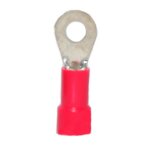Ring terminals are essential components in various electrical applications. Their design, which allows for a secure and stable connection to screws or studs, makes them highly versatile and reliable. This article will explore the most common uses for ring terminals and provide ten valuable tips for using them effectively.
Common Uses for Ring Terminals
1. Automotive Applications
In automotive applications, ring terminals are used to connect wiring to battery terminals, starter motors, and other engine components. They provide a secure and reliable connection that can withstand the vibrations and environmental conditions found in vehicles.
2. Marine Applications
Ring terminals are widely used in marine environments to connect wiring for navigation lights, bilge pumps, and other electrical systems. Their secure connection ensures reliability even in harsh conditions, such as exposure to saltwater and extreme temperatures.
3. Industrial Equipment
In industrial settings, ring terminals connect wires to machinery, control panels, and electrical enclosures. They provide a stable connection that can handle high currents and resist the wear and tear of industrial environments.
4. Home Electrical Projects
For home electrical projects, ring terminals are used to connect wiring to circuit breakers, outlets, and switches. They offer a secure and easy-to-install solution for various household electrical tasks.
5. Renewable Energy Systems
In renewable energy systems, such as solar panels and wind turbines, ring terminals connect wires to inverters, charge controllers, and batteries. They ensure a stable and efficient connection for optimal energy transfer.
6. HVAC Systems
Ring terminals are used in HVAC systems to connect wiring for thermostats, compressors, and fans. They provide a secure connection that ensures the reliable operation of heating and cooling systems.
7. Electrical Panels
In electrical panels, ring terminals connect wires to circuit breakers and grounding bars. Their secure connection helps maintain the safety and efficiency of the electrical system.
8. Appliance Repair
Ring terminals are often used in appliance repair to connect wiring within appliances such as washing machines, dryers, and refrigerators. They provide a reliable and easy-to-install solution for restoring the functionality of household appliances.
9. Telecommunications
In telecommunications, ring terminals connect wires in network equipment, servers, and communication devices. They ensure a stable connection that is critical for maintaining reliable communication networks.
10. Aerospace Applications
In aerospace applications, ring terminals are used to connect wiring in aircraft and spacecraft. Their secure connection is essential for the reliable operation of critical systems in extreme conditions.
10 Tips for Using Ring Terminals Effectively
1. Choose the Right Size

Ensure that the ring terminal matches the wire gauge and stud size you are using. A properly sized terminal provides a secure and reliable connection.
2. Use Quality Crimping Tools
Invest in a high-quality crimping tool to ensure a secure crimp. A proper crimp ensures the terminal is firmly attached to the wire, reducing the risk of loose connections.
3. Match the Material
Select ring terminals made from materials compatible with your application's environment. For example, use stainless steel terminals in marine environments for corrosion resistance.
4. Insulate Connections
Choose insulated ring terminals for applications where electrical insulation is necessary. This protects against electrical shocks and short circuits.
5. Avoid Over-Crimping
Do not over-crimp the terminal, as this can damage the wire and terminal. Follow the manufacturer's guidelines for the correct crimping pressure.
6. Check for Secure Connections
After crimping, tug gently on the wire to ensure it is securely attached to the terminal. A secure connection prevents the wire from pulling out under stress.
7. Use Heat Shrink Tubing
For added protection, use heat shrink tubing over the crimped connection. This provides additional insulation and protection against environmental factors.
8. Label Your Connections
Label the wires and terminals to ensure easy identification during installation and maintenance. This helps prevent wiring mistakes and simplifies troubleshooting.
9. Regularly Inspect Connections
Regularly inspect the connections for signs of wear, corrosion, or looseness. Replace any damaged terminals promptly to maintain the integrity of the electrical system.
10. Store Terminals Properly
Store the terminals in a dry, organized environment to prevent damage and corrosion. Keep different sizes and types separated for easy access.
Conclusion
Ring terminals are versatile and essential components in a wide range of electrical applications, from automotive and marine environments to home electrical projects and renewable energy systems. By following the tips provided, you can ensure secure and reliable connections, enhancing the safety and efficiency of your electrical projects.
For more insights and tips on cable ties and other related products, be sure to explore cabletiesunlimited.com and follow us on our social media communities on Facebook and Instagram!
Want to speak with one of our professionals? Reach out at 866-891-0137 and we'll be delighted to help!

